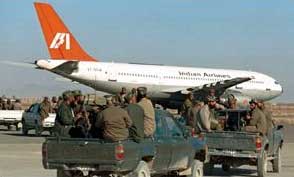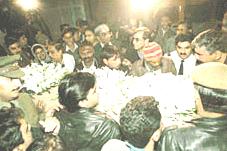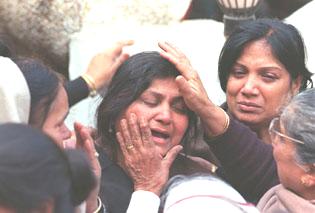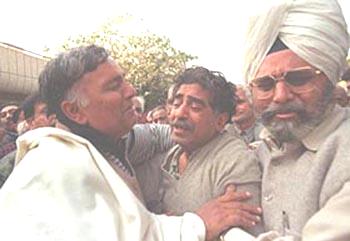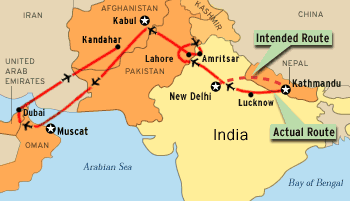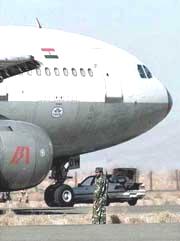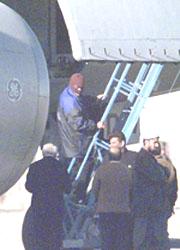Hijack of Indian Airlines flight IC-814
|
The brazen hijack of an Indian civil airline by Pakistani terrorists in December 1999 once again focussed the world's attention on Pakistan and neighbouring Afghanistan. The incident also exposed serious flaws in Nepal's airport security and brought about wide ranging reforms to Indian civil aircraft security. As irrefutable evidence of Pakistan's complicity in the hijack mounts, there is a strong push by peace loving nations around the world to bring the perpetrators of this heinous crime to book. On the afternoon of December 24, 1999, A vehicle from the Pakistan embassy drove to the Tribhuvan Airport, Kathmandu carrying Pakistani First Secretary Mohammed Arshad Cheema, his assistant Zia Ansari and a Nepali Muslim, Abdul Rias Khan. Two airport officials noted down their registration number. They also noticed that the first secretary had a briefcase. They walked into the departure lounge unchecked using their Diplomatic immunity clearance. One of the Pakistani officials handed over a briefcase to a hijacker. Two Nepali airport staff officers said that Cheema did not have the briefcase when he returned from the airport. This is not the first time Cheema, an ISI man in the Pakistan embassy in Kathmandu, has found himself in the eye of a storm. In October 1998, Yakeer Singh, a Sikh militant who was arrested in Kathmandu with 20 kg of RDX, confessed that Cheema had handed him the packet. Shortly later, five Pakistani nationals walked straight out from a Pakistan International Airlines aircraft into an Indian Airlines Airbus A300 jet sitting on the tarmac. After the hijackers took control of the plane, the Indian Airlines Airbus A300 jet with 178 passengers and 11 crew aboard was commandeered it in a zigzag trip to the Middle East and back, the hijacked plane made stops in India, Pakistan, and the United Arab Emirates, where 26 passengers were released and the body of a slain passenger was unloaded. The slain passenger -- 25-year-old Rippan Katyal -- was stabbed to death for refusing the hijackers' order to wear a blindfold. He and his wife were returning from their honeymoon in Nepal.
The plane then landed at Kandahar Airport in Afghanistan. The hijackers allowed Anil Khurana, a diabetic who had required medical treatment, to leave the plane. The remaining passengers and crew of about 155, were trapped in an odyssey of terror. There were six hijackers were aboard the plane, four were Pakistanis, one Nepalese, and one from Afghanistan. The hijackers demanded the release of a Pakistani Islamic cleric, Maulana Masood Azhar -- who has been in a high-security Kashmiri jail since 1994 -- and a number of fighters who have been seeking independence for Kashmir from India. The hijackers threatened to kill the hostages and blow up the aircraft if their demands were not met. Relatives of the passengers and crew left aboard the jet protested outside the office of Indian Prime Minister Atal Behari Vajpayee, demanding that he exchange the prisoners the hijackers wanted for their family members. In the meanwhile, New Delhi, through its High Commission in Islamabad, was working on a strategy to win over the Taliban. Essentially, India wanted the Taliban to agree to a storming operation, which the Taliban firmly refused. When it became clear that the Taliban would not play ball, the "honeymoon" between India and the Islamic militia ended. In fact, New Delhi established direct contact with Mullah Omar, the Taliban's Amir-ul-Momineen. The Taliban warned the hijackers that they would storm the aircraft if any of the hostages were hurt.
On December 31, the eight-day-long trauma for the hijacked passengers ended when Jaswant Singh travelled to Kandahar in a Boeing 737 to wrap up the deal, taking with him the three terrorists named by the hijackers. Soon after the Boeing 737 landed, around 4 p.m., Masood Azhar, Mushtaq Zargar and Omar Sayeed Sheikh were taken down, bundled into a Taliban vehicle and taken close to the hijacked aircraft. One hijacker climbed down the engineer's ladder, took a good look at the released terrorists, and then signalled the other hijackers to come down. With the hijackers leaving the aircraft, the transfer of passengers to the other two Indian planes began. Jaswant Singh, flanked by the Taliban, announced that the hijackers had been given 10 hours to leave Afghanistan. The Taliban put pressure on Jaswant Singh to make this announcement in order to ensure that India did not later accuse the Taliban of agreeing to give the hijackers safe passage. The five hijackers vanished into the desert of southern Afghanistan, making their way to Quetta, in the Paksitani side of Kashmir, through the porous borders. The authorities simply believed what the hijacked pilot told the Amritsar ATC: that the hijackers were armed with Kalashnikovs, pistols and grenades, and that they had started killing the passengers. But in reality, the hijackers had only knives and had not killed any passengers yet. "Anybody could have understood that the pilot was saying what he was told to," said an airforce officer. Later the government released tapes of the conversation between the pilot and the Amritsar air traffic control tower. "It is clearly a doctored transcript," said an air force officer. "It contains only what the pilot communicated to the ATC. The communication from the ATC to the pilot appears to have been deleted. There is not even the routine 'Roger'." There is little doubt that the entire hijacking operation was a "professional job". The manner in which the hijackers conducted themselves indicated that they had planned every move. The choice of destinations - Lahore and finally Kandahar - indicated that both Pakistan and Afghanistan were countries that would afford them protection. According to informed sources, the hijackers belong to the Harkat-ul-Mujahideen, a militant outfit in Jammu and Kashmir with which Masood Azhar has been associated. The Harkat-ul-Ansar changed its name to Harkat-ul-Mujahideen after the US declared it a terrorist outfit in 1997. The Harkat, as is well known, operates from Pakistan and is headquartered at Muzaffarabad in the Pakistani side of Kashmir.
Indian Home minister L.K Advani made a "significant breakthrough" in the trail of the IC-814 hijackers, which had led him to Pakistan. The minister named five Pakistanis as the hijackers. The one addressed as 'Chief' by the other hijackers was Ibrahim Athar of Bahawalpur; "Burger' was Sunny Ahmed Qazi of Defence Area, Karachi; 'Doctor' was Shahid Akhtar Sayed of Gulshan Iqbal area in Karachi; 'Bhola' was Mistri Zahoor Ibrahim of Akhtar Colony, Karachi; and 'Shankar' was Shaqir from Sukkur. The breakthrough actually came on the cold Kandahar night of December 29 when the hijackers contacted one of their associates in Pakistan who in turn called a Mumbai number. The accomplice in Mumbai was told to inform a television correspondent in London to put out the news that the plane would be blown up if the demands were not met. The call was intercepted which led to the arrest in Mumbai of accomplice Abdul Latif(who received the call), Mohammed Rehan, Mohammed Iqbal(both Pakistanis) and Yusuf Nepali, a Nepal citizen. Latif apparently was the kingpin at the Indian end, having escorted 'Chief' Athar on November 1 from Mumbai to Calcutta by air, to New Jalpaiguri by train and from there to Kathmandu by bus. Exactly a month later he took Shaqir('Shankar') by train to Gorakhpur and further to Kathmandu by bus. Then on December 17 he flew to Kathmandu and returned later by train. The date of the hijacking was advanced by three days after the hijackers got a call from Delhi on December 20 or 21. It had been planned for December 27. The hijackers used satellite phones of the Kunal Guest House in Kathmandu to place several calls. They made calls to the Mumbai associate of underworld don Chotta Shakeel and a phone call to London to a woman who was closely connected with Yusuf Sulaiman Motala, a businessman. Motala has been identified by intelligence agencies as one of the financiers of Hizbul-Mujahideen. The four "spilt the beans" claiming they are operatives of Hizbul-Mujahideen, Latif is said to have been in the Gulf region from where he was recruited by the ISI which trained him in camps in Pakistan and Afghanistan. According to the home minister, the "interrogation has confirmed that the hijack was an ISI operation executed with the assistance of Hizbul-Mujahideen." But the big question remains: why didn't the organisation claim credit, as is the standard terrorist practice the world over? The only explanation given by home ministry officials was that Harkat is actually an overground organisation, claiming to be a political outfit and would not risk being branded once again as a terror group. But the home ministry would have it that the operation was not merely that of one outfit, but the Pakistan state itself was involved, which buttresses Prime Minister A.B. Vajpayee's demand to the US to brand that country a rogue state, much like Libya. The aftermath: Indian civil aviation underwent several security upgrades. Indian aircrafts now carry security air marshals to prevent any repeat incident. So far, despite insurmountable evidence, Pakistan still refuses to hand over the hijackers. They claim the hijackers have commited no crime and broken no Pakistani laws. On 12th April 2001, Pakistani First Secretary Mohammed Arshad Cheema was arrested by Nepal police for possessing more than 16 kilograms of the high explosive RDX (A pontent version of C-4). Cheema's wife and two Nepalese nationals were also detained. On 14th April, Cheema and his wife were expelled from Nepal. One of the released militants Maulana Masood Azhar roams freely in Pakistan, where he has formed his own militant group - Jaish-e-Mohammad (Army of the Prophet) that is now responsible for the attacks on the Indian Parliament (14 killed), the Kashmir State Assembly (39 killed) and dozens of attacks on civilians and security forces in India. He regularly organizes meetings where his members indulge in anti-India tirades and collect donations for a "Jihad" against India and the western world. Ma Another terrorist released due to the hijacking, Omar Sayeed Sheikh went on to behead American journalist Daniel Pearl and was sentenced to death but has not been executed due to reluctance by Pakistani authorities. Both Maulana Masood Azhar and Omar Sayeed Sheikh also wired $100,00 to the September 11th hijackers. The IC 814 Hijacking also had a similar modus operandi to the September 11th hijacks. Most intelligence agencies believed that the hijacking of IC-814 was a practice run for the September 11th attacks. Links |

